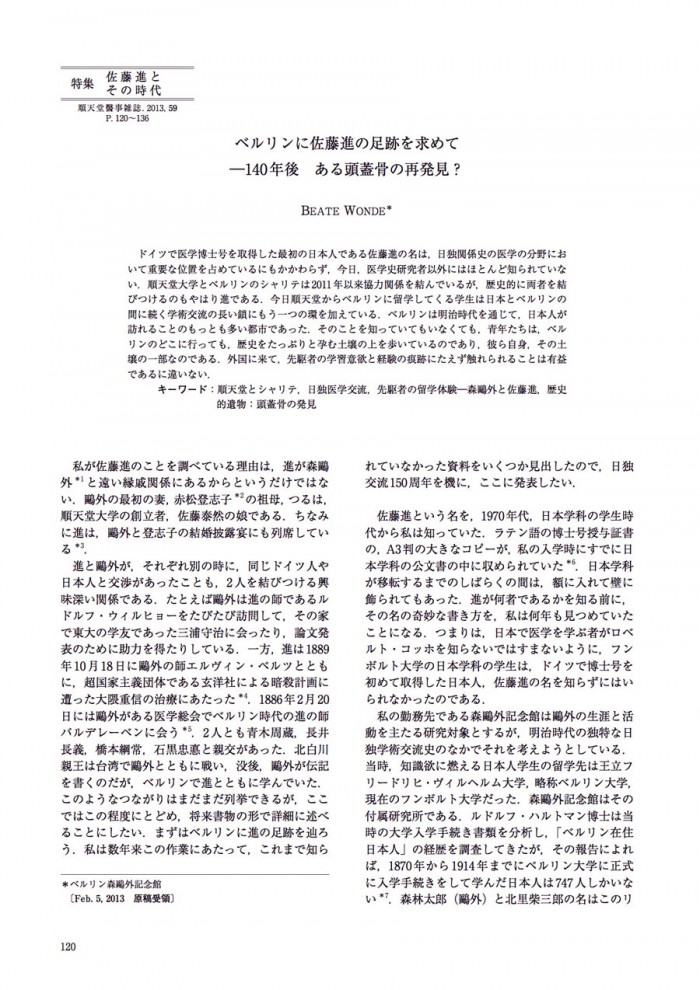ベルリンに佐藤進の足跡を求めて ―140 年後 ある頭蓋骨の再発見?
SEARCHING FOR EVIDENCE OF SATÔ SUSUMUʼS MEDICAL STUDY IN BERLIN, 1869-1874 THE DISCOVERY OF A SKULL 140 YEARS AFTER THE IWAKURA MISSION
AND A CUTTING FROM A GERMAN NEWSPAPER REPORTING ON THE DAY OF SUSUMUʼS GRADUATION
When Juntendô University and Charité-Universitätsmedizin Berlin signed a contract of cooperation in 2011, this was one further step in the history of medical relations between Germany and Japan, which go back more than 300 years. Satô Susumu, the first Japanese who took an official degree of Doctor of Medicine in Germany, played an important role in the history of these medical relations.
What kind of city did he encounter, when he arrived in Berlin in October 1869 shortly before the outbreak of the Franco-Prussian War? Who were his fellow students and what were the requirements for a formal full 4-year medical study at the University of Berlin? Who were his eminent teachers and what were their special skills and their personal characters?
In contrast to Mori Ôgai, who left a detailed “German diary” in which he recorded his days in Germany more than one decade later (1884-88), there is little evidence of Satô Susumu’s study in Berlin. Apart from Sato’s certificates, which are kept securely in the archives of Humboldt University, there is a skull of a Japanese from Yeddo (Edo) in the skull collection in the Museum of Prehistory in Berlin. This might be the one that Satô ordered for his teacher, the anatomist Bogislaus Reichert, and which was presented by Ōkubo Toshimichi, a member of the Iwakura mission, in 1873.
Until recently, it was not known exactly on what day Satô Susumu sat his examination for his doctor’s degree and how the graduation ceremony was held, but the author has found a newspaper cutting that reports on this historical event on 10th August, 1874, and shows that the ceremony followed the conventions of the University of Berlin at that time.
Beate Wonde, the author of this article, has given several lectures on German-Japanese medical history at symposia by Juntendô and Charité. That she also, as Curator of the Mori Ôgai Memorial in Berlin, shines a light on the various associations between Satô and Ôgai and on the footprints they left behind in Berlin, is not surprising.
ドイツで医学博士号を取得した最初の日本人である佐藤進の名は,日独関係史の医学の分野にお いて重要な位置を占めているにもかかわらず,今日,医学史研究者以外にはほとんど知られていな い.順天堂大学とベルリンのシャリテは 2011 年以来協力関係を結んでいるが,歴史的に両者を結 びつけるのもやはり進である.今日順天堂からベルリンに留学してくる学生は日本とベルリンの 間に続く学術交流の長い鎖にもう一つの環を加えている.ベルリンは明治時代を通じて,日本人が 訪れることのもっとも多い都市であった.そのことを知っていてもいなくても,青年たちは,ベル リンのどこに行っても,歴史をたっぷりと孕む土壌の上を歩いているのであり,彼ら自身,その土 壌の一部なのである.外国に来て,先駆者の学習意欲と経験の痕跡にたえず触れられることは有益 であるに違いない.
キーワード:順天堂とシャリテ,日独医学交流,先駆者の留学体験―森鷗外と佐藤進,歴史 的遺物:頭蓋骨の発見

Text Juntendô Medical Journal als PDF-Dokument öffnen
Vergleiche auch:

 Beate Wonde
Beate Wonde